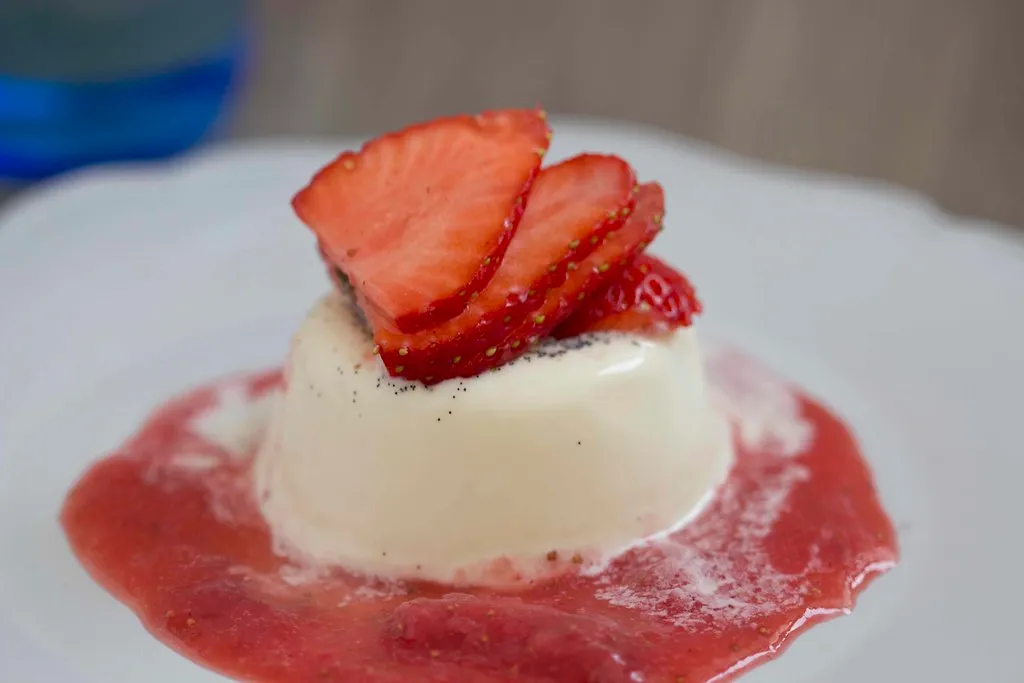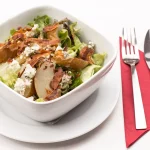The Best Fluffy Pancakes recipe you will fall in love with. Full of tips and tricks to help you make the best pancakes.
Few desserts capture the elegance of Italian cuisine quite like panna cotta. Silky, creamy, and lightly sweetened, this classic Italian dessert is surprisingly simple to prepare at home. Made with just a handful of ingredients—cream, milk, sugar, vanilla, and a touch of gelatin—panna cotta transforms into a luscious treat that looks and tastes as if it came straight from a restaurant.
What makes panna cotta so special is its versatility. Whether topped with fresh berries, drizzled with a vibrant fruit sauce, or paired with chocolate or caramel, it’s a no-bake Italian dessert that feels both light and indulgent. Perfect for dinner parties, holidays, or even a casual sweet craving, panna cotta offers the ideal balance between sophistication and simplicity.
In this guide, you’ll learn how to make panna cotta at home step by step, discover delicious variations, and pick up tips to ensure your dessert sets perfectly every time. By the end, you’ll have all the confidence you need to create this timeless Italian favorite in your own kitchen.
What Is Panna Cotta? A Classic Italian Dessert
Panna cotta, which translates to “cooked cream” in Italian, is one of the most beloved desserts in Italian cuisine. Known for its silky-smooth texture and delicate flavor, this dessert has become a favorite not just in Italy but around the world. It’s often seen as an elegant treat on restaurant menus, yet it’s surprisingly easy to recreate in your own kitchen.

Unlike other custard-based desserts such as crème brûlée or flan, panna cotta does not rely on eggs for thickening. Instead, it uses gelatin (or agar-agar for a vegetarian option) to set the mixture of cream, milk, sugar, and vanilla into a lightly firm yet creamy consistency. This makes panna cotta unique—it holds its shape when unmolded, but it melts smoothly on the tongue.
Traditionally, panna cotta is flavored with vanilla beans and served with fresh fruit or a berry sauce to balance its creamy richness. However, modern variations include everything from coffee and chocolate to tropical fruits like passion fruit and mango. Its adaptability is one reason why panna cotta has remained a timeless favorite across cultures.
In Italian tradition, panna cotta is often enjoyed at family gatherings, celebrations, and even as a refreshing end to a multi-course meal. With its simple ingredients and no-bake method, it represents the heart of Italian cooking: turning basic pantry staples into something truly extraordinary.
Ingredients You’ll Need for Authentic Panna Cotta
The beauty of panna cotta lies in its simplicity—just a few high-quality ingredients come together to create a creamy, luxurious dessert. To achieve the classic Italian panna cotta flavor and texture, here are the essential components you’ll need:
Essential Base Ingredients
At its core, panna cotta is made with heavy cream, a bit of whole milk, sugar, and vanilla. The cream provides richness and that silky mouthfeel, while milk helps balance the texture so it isn’t overly heavy. A touch of sugar sweetens the mixture without overpowering the delicate flavors. For the best results, use fresh dairy products and pure vanilla extract—or better yet, a whole vanilla bean for that authentic speckled look and deep flavor.
The Role of Gelatin (or Agar-Agar)
Unlike custards that use eggs, panna cotta relies on gelatin to set. Gelatin allows the mixture to firm up while still remaining soft and creamy. Powdered gelatin or gelatin sheets can be used depending on what’s available. For a vegetarian-friendly option, agar-agar works as a substitute, though it sets slightly firmer than traditional gelatin. Mastering the balance of cream to gelatin is key to achieving panna cotta’s signature “wobble.”
Flavor Enhancers and Toppings
While the classic version highlights vanilla, panna cotta is wonderfully versatile. You can infuse the cream with coffee, citrus zest, cocoa, or even spices like cardamom to give it a unique twist. Toppings elevate the dessert—think fresh berries, raspberry coulis, caramel drizzle, or shaved chocolate. These not only add flavor contrast but also make the presentation stunning.
Substitutions for Dietary Needs
If you’re making panna cotta for a crowd, you might need to consider dietary preferences. Coconut milk or almond milk can replace dairy for a lactose-free version, while natural sweeteners like honey or maple syrup can be used instead of refined sugar. With a few simple adjustments, panna cotta can easily be adapted to suit vegan, vegetarian, or low-sugar diets without losing its creamy charm.
Step-by-Step Guide to Making Creamy Panna Cotta
Creating a silky, creamy panna cotta at home is easier than it looks. Follow these steps carefully, and you’ll achieve a dessert that wobbles perfectly yet melts in your mouth.
Ingredients (Serves 4–6)
- 2 cups (480 ml) heavy cream
- 1 cup (240 ml) whole milk
- 1/2 cup (100 g) granulated sugar
- 1 vanilla bean, split and scraped (or 1 tsp vanilla extract)
- 2 1/2 tsp powdered gelatin (or 3 sheets gelatin)
- 3 tbsp cold water (for blooming gelatin)
Optional toppings: fresh berries, berry coulis, caramel, chocolate shavings, or mint leaves
Prepare the Gelatin
- Place gelatin in a small bowl with cold water and let it sit for 5–10 minutes to bloom.
- This step ensures the gelatin dissolves evenly and sets the panna cotta properly.
Heat the Cream Mixture
- In a medium saucepan, combine heavy cream, milk, and sugar.
- Split the vanilla bean and scrape the seeds into the mixture, adding the pod as well (or add vanilla extract at the end if using).
- Heat over medium heat until the sugar is fully dissolved and the mixture is hot but not boiling (about 5–7 minutes).
Incorporate the Gelatin
- Remove the saucepan from heat.
- Discard the vanilla pod if used.
- Add the bloomed gelatin to the hot cream mixture and stir until completely dissolved.
Pour Into Molds
- Divide the mixture evenly into ramekins, cups, or molds.
- Let the mixture cool slightly at room temperature (5–10 minutes) before refrigerating.
Chill and Set
- Cover the molds with plastic wrap to prevent a skin from forming.
- Refrigerate for at least 4 hours, or until the panna cotta is firm but slightly jiggly.
Serve
- To unmold, dip the bottom of each ramekin in warm water for 5–10 seconds.
- Gently invert onto a serving plate.
- Top with fresh berries, a drizzle of sauce, or chocolate shavings for a stunning presentation.
✨ Tips for Perfect Panna Cotta:
- Do not boil the cream; it can affect the texture.
- Ensure gelatin is fully dissolved to avoid graininess.
- Let the panna cotta chill long enough—rushing this step can result in a runny dessert.
Delicious Panna Cotta Variations to Try
One of the best things about panna cotta is its versatility. While the classic vanilla version is timeless, experimenting with flavors and toppings can elevate your dessert to new heights. Here are some delicious variations you can try at home:
1. Classic Vanilla Panna Cotta with Fresh Berries
- Ingredients:
- Fresh strawberries, raspberries, or blueberries
- 1 tbsp sugar (optional for macerating berries)
- How to serve: Lightly toss berries with sugar to release their natural juices, then spoon them over the set panna cotta. This combination creates a perfect balance of creamy richness and tart freshness, highlighting the traditional Italian flavor.
2. Chocolate Panna Cotta
- Ingredients:
- 2 oz (55 g) dark chocolate, melted
- 1/2 tsp espresso powder (optional, enhances chocolate flavor)
- How to make: Stir melted chocolate and espresso powder into the warm cream mixture before adding gelatin. Serve with chocolate shavings or a drizzle of chocolate sauce for an indulgent twist on the classic dessert.
3. Coffee or Espresso Panna Cotta
- Ingredients:
- 1–2 tsp instant espresso or strong brewed coffee
- How to make: Add the coffee to the cream mixture as it heats. The result is a subtle coffee-flavored panna cotta that pairs beautifully with chocolate or caramel toppings—a sophisticated option for coffee lovers.
4. Tropical or Fruit-Infused Panna Cotta
- Ingredients:
- Mango puree, passion fruit pulp, or pineapple compote
- How to serve: Swirl fruit puree on top or layer it for a colorful, tropical dessert. This variation works well for summer gatherings and adds a refreshing fruity twist to the creamy base.
5. Mini Panna Cotta Cups for Parties
- Ingredients: Same base as classic panna cotta
- How to serve: Pour the mixture into small cups or shot glasses instead of ramekins. Top each with berries, chocolate, or a small caramel drizzle. These bite-sized desserts are perfect for buffets, celebrations, or dinner parties, and they make presentation extra elegant.
✨ Tips for Variations:
- Adjust the sweetness according to the flavor of toppings—fruity or chocolatey add-ins may require less sugar.
- Layering flavors (like coffee chocolate or vanilla berry) creates a gourmet look and taste.
- Always let the panna cotta chill completely before adding toppings for the cleanest presentation.
Tips for Serving, Storing, and Perfecting Panna Cotta
While panna cotta is simple to make, a few expert tips can ensure it turns out perfectly every time and looks stunning on the table. These tips will help you serve, store, and refine your dessert like a professional.
1. Presentation Ideas for Elegant Serving
- Serve panna cotta in ramekins, wine glasses, or small jars for a sophisticated look.
- Garnish with fresh berries, berry coulis, chocolate shavings, or edible flowers to add color and contrast.
- Drizzle caramel, chocolate, or fruit sauce just before serving for a professional finish.
- For layered panna cotta, allow each layer to chill until set before adding the next for clean, defined lines.
2. How to Unmold Panna Cotta Perfectly
- Briefly dip the bottom of ramekins in warm water for 5–10 seconds to loosen the edges.
- Run a thin knife around the sides to help release the dessert.
- Invert onto a plate gently, shaking slightly if needed.
- If you prefer, panna cotta can also be served directly in the mold for a rustic, easy presentation.
3. Storing Panna Cotta
- Cover panna cotta with plastic wrap or airtight lids to prevent absorbing odors from the fridge.
- Refrigerate for up to 3 days. Avoid freezing, as this can ruin the creamy texture.
- Add toppings or sauces just before serving, not during storage, to maintain freshness and visual appeal.
4. Common Mistakes to Avoid for Perfect Texture
- Overheating the cream can cause a grainy texture—heat just until hot, not boiling.
- Not dissolving the gelatin completely can result in lumps or uneven setting.
- Rushing the chilling time will lead to panna cotta that is too soft and may collapse when unmolded.
- Avoid using low-quality cream or milk, as freshness impacts the final silky texture.
✨ Pro Tip: For a luxurious panna cotta experience, pair it with complementary flavors like a tangy berry sauce, citrus zest, or coffee-infused chocolate. Small touches like this elevate a simple dessert into a gourmet treat.





